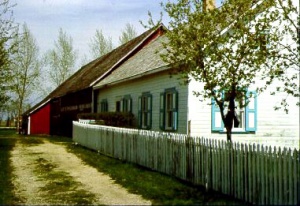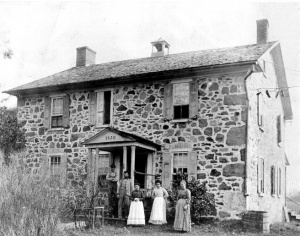Difference between revisions of "Interpretation and Information Centers"
| [unchecked revision] | [unchecked revision] |
GameoAdmin (talk | contribs) (CSV import - 20130816) |
GameoAdmin (talk | contribs) (CSV import - 20130820) |
||
| Line 62: | Line 62: | ||
Additionally, numerous slide programs on the Amish and Mennonites have been developed and have contributed significantly to dissemination of information at the established information centers as well as at hundreds of meetings responding to the renewed interest by church and civic groups. | Additionally, numerous slide programs on the Amish and Mennonites have been developed and have contributed significantly to dissemination of information at the established information centers as well as at hundreds of meetings responding to the renewed interest by church and civic groups. | ||
| − | |||
| − | |||
= Bibliography = | = Bibliography = | ||
Current lists of interpretation and information centers are published in the <em class="gameo_bibliography">Mennonite Directory.</em> | Current lists of interpretation and information centers are published in the <em class="gameo_bibliography">Mennonite Directory.</em> | ||
Hunsberger, Gordon. "The Mission of the Meetingplace." <em class="gameo_bibliography">WMSC Voice</em> 60 (October 1986): 6-7. | Hunsberger, Gordon. "The Mission of the Meetingplace." <em class="gameo_bibliography">WMSC Voice</em> 60 (October 1986): 6-7. | ||
| − | |||
| − | |||
= Additional Information = | = Additional Information = | ||
[http://www.fieldtrip.com/pa/74644438.htm Hans Herr House] (Lancaster, Pa.) | [http://www.fieldtrip.com/pa/74644438.htm Hans Herr House] (Lancaster, Pa.) | ||
| Line 76: | Line 72: | ||
[http://www.behalt.com/ Mennonite Information Center] (Berlin, Ohio) | [http://www.behalt.com/ Mennonite Information Center] (Berlin, Ohio) | ||
| − | |||
| − | |||
{{GAMEO_footer|hp=Vol. 5, pp. 452-454|date=1989|a1_last=Yoder|a1_first=Samuel L|a2_last= |a2_first= }} | {{GAMEO_footer|hp=Vol. 5, pp. 452-454|date=1989|a1_last=Yoder|a1_first=Samuel L|a2_last= |a2_first= }} | ||
Revision as of 19:49, 20 August 2013
The international attention given Amish and Mennonite communities has brought an influx of tourists to see first hand people in a living museum on their own turf. This is a recent phenomenon as more and more city dwellers seek to escape the fast pace of urban life in search for the quiet and peaceful environment of rural America. With increased attention from the media of mass communication to their unique way of life, Amish and conservative Mennonite communities have become prime tourist spots. In the last several decades every major Amish community in America has established an information center. In most cases, Mennonites have taken the initiative in establishing information centers as a response to the thousands of inquiries about a people who choose not to be modern, inquiries that frequently have received ambiguous or erroneous answers when addressed to the people in nearby towns. There is a strong cultural wall between the Amish and the tourist; a wall the Amish hope to maintain. Amish see their religion and culture as a private matter and therefore have great reluctance to share their life-style with the outside world. Preaching in Amish church services dwells heavily on nonconformity to the ways of the world. This throws a cloud of secrecy over church functions and creates a reticence to open their society to the outsider, especially the tourist.
In contrast, many information centers operate with all the latest technologies, e.g., video cassettes, film, and audio tapes to tell the Anabaptist story as comprehensively as possible. Most of the information centers have animated visual effects to depict with all the drama of an epic movie aspects of the Protestant Reformation and Anabaptist persecution, migrations, and modern-day faith in action. A recent trend at many centers is the preparation of full-color pamphlets giving a strong Anabaptist message with the intent of low-key evangelism. Professionally prepared literature is widely distributed in order to compete for the tourist's time and attention.
Information centers have many times helped the Amish and conservative Mennonites by giving correct information while encouraging the tourist to respect the groups' desire for privacy and peace and quiet in their daily lives. Information centers in large tourist areas have contributed much to the economic climate of the area. Special Amish and Mennonite cooking is a favorite of tourists. Bed-and-breakfast lodging, sometimes in Amish/Mennonite homes, is a delight to the visitor. A variety of craft shops and quilt barns have all brought a degree of prosperity to some Amish and Mennonite communities. Most information centers operate without admission charge, although there is ample opportunity for visitor donations. Other centers operate as profit-making business enterprises.
While most of the interest in Amish and Mennonite religion and culture seems to be in the United States and Canada, there are several similar centers of note in other countries. The Menno Simons Center in Witmarsum, in The Netherlands receives many visitors from all parts of the world. Located in the heart of early Anabaptist history in the 16th century, the center becomes an appropriate stop for Mennonite tourists making the trek to Witmarsum to visit the Menno Simons monument. A second information center is located in Tokyo, Japan. The Anabaptist Center serves Mennonites as a home while in Tokyo, however, its primary function is to disseminate Anabaptist information to the Japanese. Additional information and study centers can be found in London, Paris, and Brussels.
Some of the most notable visitor and information centers in North America are:
Mennonite Information Center, Lancaster, PA, one of the first and most complete information centers, is located in the heart of one of the top ten tourist centers in the United States.
Mennonite Heritage Center, Harleysville, PA, displays three centuries of Mennonite life.
People's Place, Intercourse, PA, exhibits Amish and Mennonite heritage and culture through art and film and provides one of the largest collections of books on Amish, Mennonites, and Hutterites.
Mennonite Information Center, Berlin, Ohio, provides information on the history, religion, and customs of the Amish and Mennonites who farm, run businesses, and raise their families in this rural, quiet, rolling countryside in Holmes County. It features the large "Behalt" mural of Mennonite history and faith.
Menno-Hof, Mennonite and Amish Visitor Center, Shipshewana, IN, tells the story of the Anabaptist origins, persecution, migrations, and faith in action in an early meetinghouse setting.
Mennonite Heritage Village, Steinbach, Man. tells the story of the 1870s Mennonite migration to Manitoba in a pioneer village and museum.
Millbank Information Centre, Millbank, ON interprets the Amish and Mennonite story in the local area.
Mennonite Heritage Center, Metamora, IL, portrays honestly and in depth the characteristics and the pilgrimages of the various Mennonite groups in Illinois.
Visitor Centre (formerly The Meeting Place), St. Jacobs, ON, offers information on early Anabaptists and contemporary Mennonites in Ontario.
Heritage Historical Library, Aylmer, ON, is a collection of resources for researchers in Amish history and genealogy.
Brubacher House, Waterloo, Ont., is a restoration of a 19th century Mennonite house. Located on the campus of the University of Waterloo.
Warkentin House, Newton, Kansas, a 19th century Mennonite house featuring Turkey Red wheat brought to America by the Russian Mennonites.
Hans Herr House Museum, Willow St., Pennsylvania is the oldest (1719) house in Lancaster County, Pennsylvania.
Illinois Amish Interpretive Center, Arcola, IL portrays the Amish/Mennonite faith.
Kauffman Museum, North Newton, KS on the campus of Bethel College features the story of the Mennonites in relation to the Great Plains.
The Mennonite Settlement Museum , Hillsboro, KS is in the Hillsboro Heritage Park, and includes the pioneer home built in 1876 by Peter Loewen.
In addition to the major information centers listed above, there are a number of similar centers featuring Amish farms, amusement parks, Pennsylvania Dutch or Low German restaurants, and craft shops.
Other attempts at bringing the Mennonite, Amish, and Hutterite story to a wider audience make use of filmmaking. In the last decades, several full-length films were produced, some achieving national acclaim. A major commercial feature film entitled "Witness" was filmed in Pennsylvania using the Amish countryside in Lancaster County as a setting for this murder mystery. Its portrayal of Amish life was not authentic. Some of the most successful films produced and available today are The Amish: people of preservation, an excellent presentation of the Lancaster County. Amish with good historical content; Hazel's people, which combines professional excellence with faithfulness to the spirit of the Mennonite community; And when they shall ask, which presents the story of the Russian Mennonites, their life in the rich farmlands of South Russia, persecution, and finally, emigration; Menno's reins, a dramatic documentary on the Russian Mennonites in Canada; The Hutterites, a classic on the Hutterite colonies in northwest United States and western Canada, with strong emphasis on the religious community, faith, and way of life; Beyond the buggy, a documentary on the Amish community in northern Indiana, the third largest in North America; Choosing not to be modern, a documentary filmed in Holmes County, Ohio, by two New Yorkers who lived in the community and won the confidence of some Amish.
Additionally, numerous slide programs on the Amish and Mennonites have been developed and have contributed significantly to dissemination of information at the established information centers as well as at hundreds of meetings responding to the renewed interest by church and civic groups.
Bibliography
Current lists of interpretation and information centers are published in the Mennonite Directory.
Hunsberger, Gordon. "The Mission of the Meetingplace." WMSC Voice 60 (October 1986): 6-7.
Additional Information
Hans Herr House (Lancaster, Pa.)
Mennonite Heritage Center (Harleysville, Pa.)
Mennonite Information Center (Berlin, Ohio)
| Author(s) | Samuel L Yoder |
|---|---|
| Date Published | 1989 |
Cite This Article
MLA style
Yoder, Samuel L. "Interpretation and Information Centers." Global Anabaptist Mennonite Encyclopedia Online. 1989. Web. 16 Apr 2024. https://gameo.org/index.php?title=Interpretation_and_Information_Centers&oldid=88250.
APA style
Yoder, Samuel L. (1989). Interpretation and Information Centers. Global Anabaptist Mennonite Encyclopedia Online. Retrieved 16 April 2024, from https://gameo.org/index.php?title=Interpretation_and_Information_Centers&oldid=88250.
Adapted by permission of Herald Press, Harrisonburg, Virginia, from Mennonite Encyclopedia, Vol. 5, pp. 452-454. All rights reserved.
©1996-2024 by the Global Anabaptist Mennonite Encyclopedia Online. All rights reserved.


